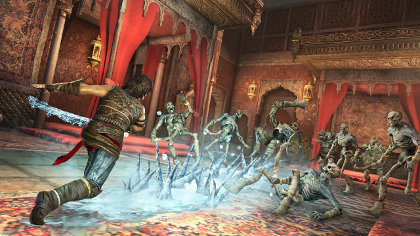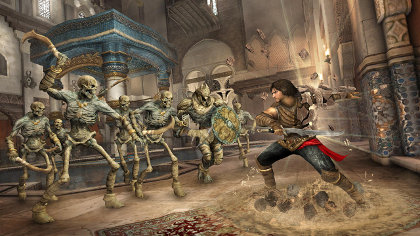He’s not necessarily the Prince that could take over a kingdom, like his brother Malik, but he’s definitely prepared to do the right thing. He’s not the poofy pants guy from Sands of Time. We try to balance it and give it a good mix, and I think this approach is pretty nice.
VGD: I think the Prince has always been defined and redefined in part through companions like Farah, Kaileena and Elika. Two Thrones perhaps goes to the extreme of that idea, with the companion in question manifest inside the Prince’s own psyche…
Sjovall: Because that’s the cheapest way of doing it! Elika was extremely hard to do, because not only do you have to do a complete set of animations for her, she has to follow the Prince, do everything Prince does but in a different way, you have to have the AI which stays out of your way, so she’s not blocking you or being a nuisance, the AI system where you can talk to her the whole time, and she brings parts of the story to you that you cannot access any other way…
That was a huge system, in terms of project management and money, it was massive. But if you talk to your sword, like in a lot of games, or you talk to your own head – like ‘hey, I’m doing well, how are you?’ – it’s bizarre!
I thought Elika was extremely awesome. Could have been better implemented, even better than she was, maybe more thought through in terms of how the perception would be – but you never really know. I really liked her, but it’s such a big part of development it becomes hard for teams to go through with this, and say ‘hey, yeah, we’ll make a companion, no matter what it costs we’ll put her through’.
Only large teams like Ubisoft’s can do that. A small team that has 40 or 50 people in it, there’s no way in hell. I mean, there’s Alyx Vance from Half-Life 2, but that’s a first-person shooter, it’s a bit different. But still, she was a huge influence for us. We looked at that character in order to see how we could make ours.
VGD: I agree that she was a marvellous achievement, and I think it’s a shame some critics didn’t look deeper than the ‘school mistress’/'jock’ relationship she had with the Prince.
Sjovall: Yesterday I had a couple of drinks with Andrew Walsh, who was the narrative director on the 2008 game – he’s working out of London. And it’s always this thing, because of the way he wrote the two characters, you’re trying to bring a certain kind of humour into this, and this is being perceived by some people very differently, some people good, some bad, and it’s just tough. I think that the Prince was getting hit a little harder by some of dialogue things that happened, because some people didn’t get it or didn’t want to get it. Eh, whatever!
VGD: I reacted quite negatively to the 2008 Prince at the preview stage, but on playing the game through I grew to like him. Another way we might think about the character is through his enemies. The last game perhaps explored this to the greatest extent, with more of a Shadow-of-the-Colossus-style boss template. Are you continuing with that idea at all?
Sjovall: No, we tried to get away from the ICO or Shadow of the Colossus type of gameplay. The two titles are probably huge influences for Prince of Persia 2008 – ICO, because you have two characters almost connected at the hip, and Shadow of the Colossus because you obviously have five main bosses that you concurrently fight, over each level you fight them once and then in the last one for a final showdown.







 Satoru Iwata Video Interview - the late Nintendo president spoke with Kikizo in 2004 as 'Nintendo Revolution' loomed.
Satoru Iwata Video Interview - the late Nintendo president spoke with Kikizo in 2004 as 'Nintendo Revolution' loomed. Kaz Hirai Video Interview - the first of Kikizo's interviews with the man who went on to become global head of Sony.
Kaz Hirai Video Interview - the first of Kikizo's interviews with the man who went on to become global head of Sony. Ed Fries Video Interview - one of Xbox's founders discusses an epic journey from Excel to Xbox.
Ed Fries Video Interview - one of Xbox's founders discusses an epic journey from Excel to Xbox. Yu Suzuki, the Kikizo Interview - we spend time with one of gaming's most revered creators.
Yu Suzuki, the Kikizo Interview - we spend time with one of gaming's most revered creators. Tetris - The Making of an Icon: Alexey Pajitnov and Henk Rogers reveal the fascinating story behind Tetris
Tetris - The Making of an Icon: Alexey Pajitnov and Henk Rogers reveal the fascinating story behind Tetris Rare founders, Chris and Tim Stamper - their only interview? Genuinely 'rare' sit down with founders of the legendary studio.
Rare founders, Chris and Tim Stamper - their only interview? Genuinely 'rare' sit down with founders of the legendary studio. The History of First-Person Shooters - a retrospective, from Maze War to Modern Warfare
The History of First-Person Shooters - a retrospective, from Maze War to Modern Warfare